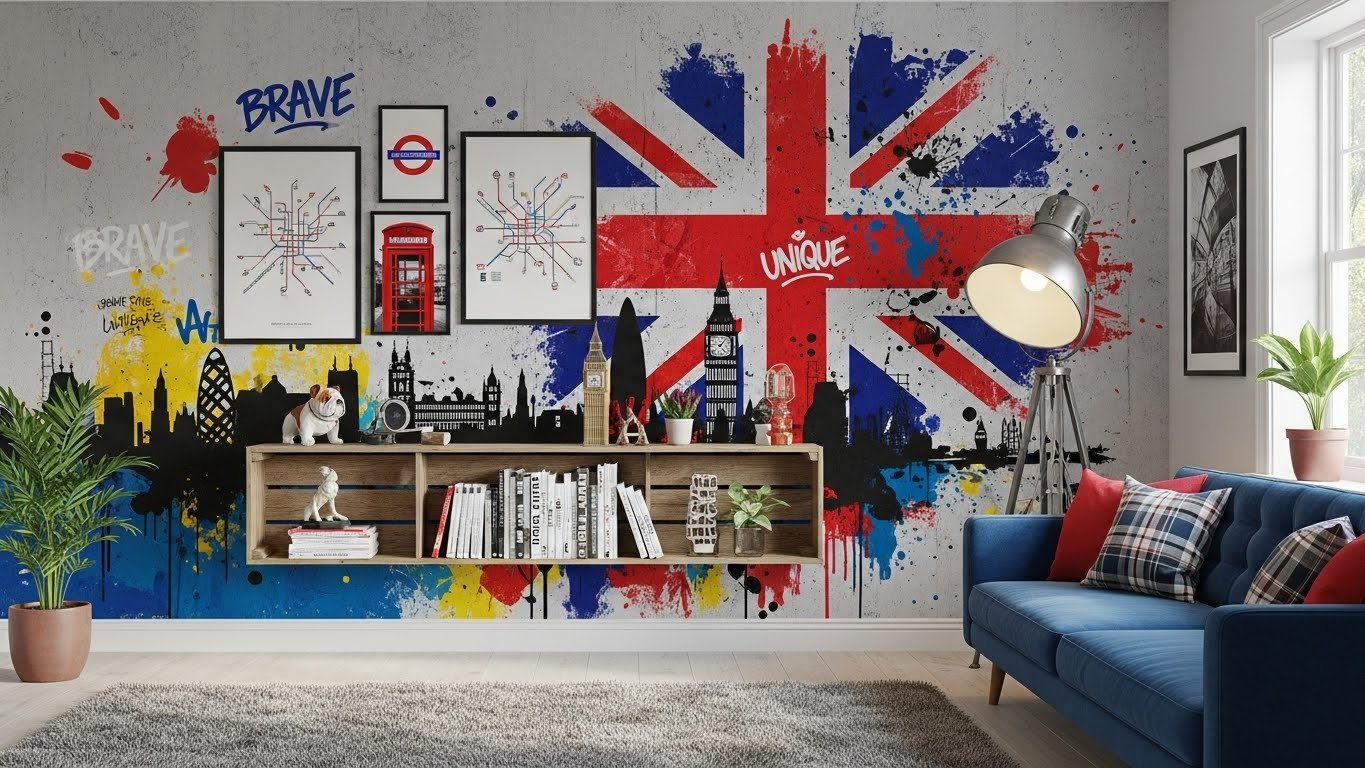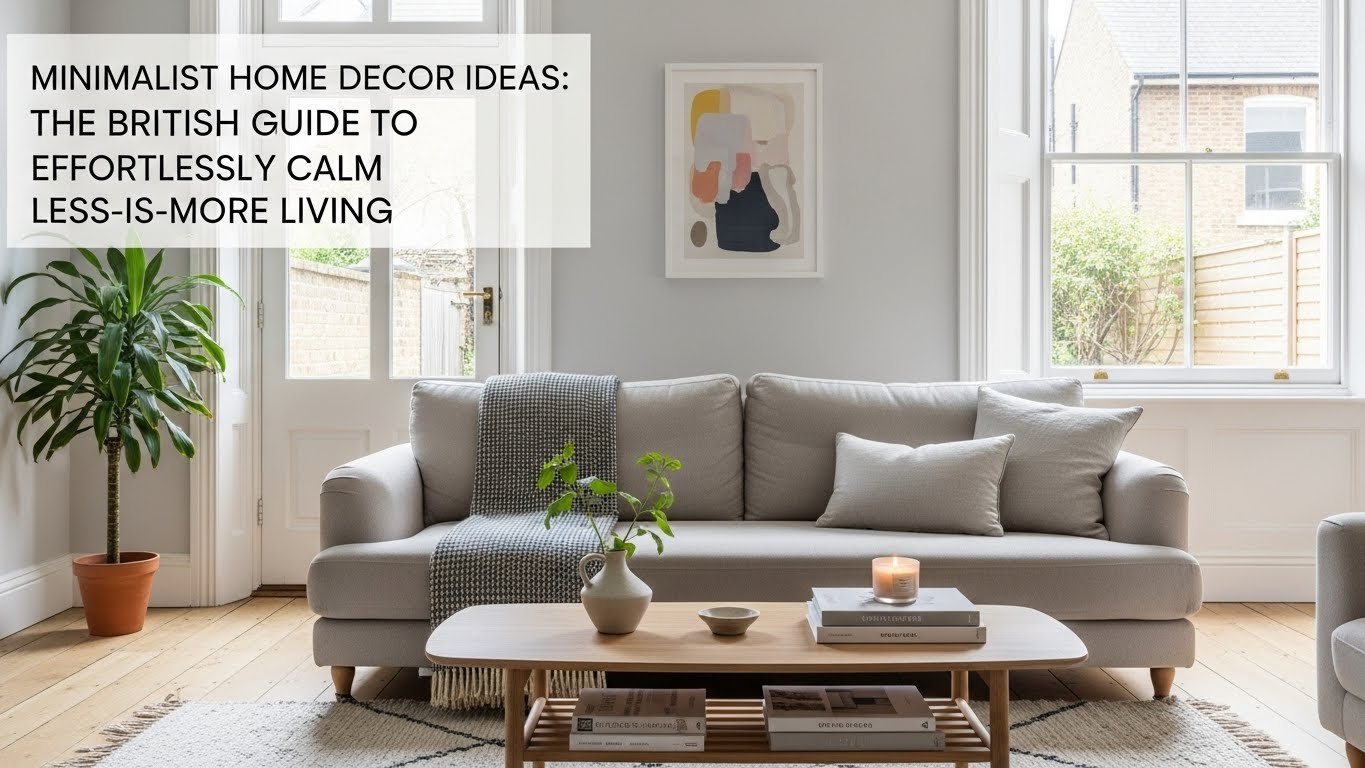Designing an open concept space can seem tough. But, knowing the key elements helps you make a harmonious and useful area.
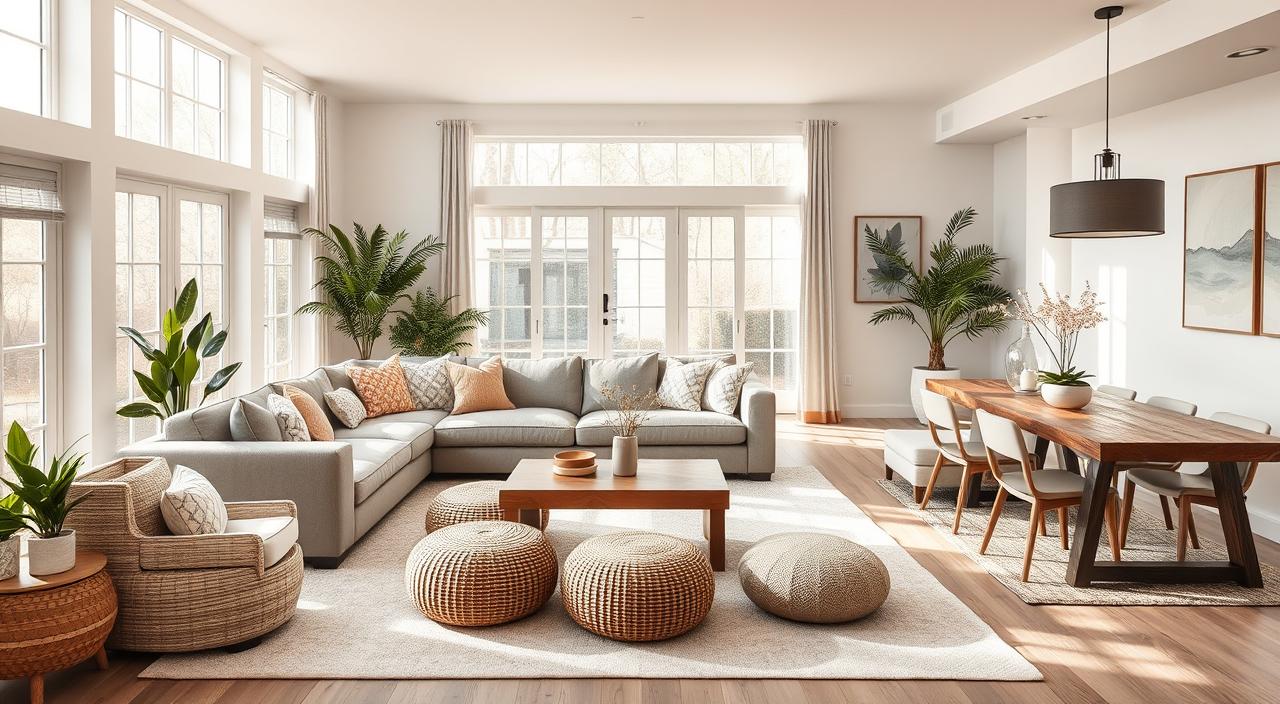
An open concept living area needs careful thought in home decor. You must think about the layout, colours, and furniture for a unified look.
Choose furniture that does more than one thing. Use a neutral colour scheme to make the space feel connected.
This way, you’ll get a stylish and practical space that suits your lifestyle.
Understanding Open Concept Living Spaces
Creating a cohesive open concept living room needs a deep understanding. You must know how to make the most of its benefits and handle its challenges.
Open concept living spaces are versatile and welcoming. They merge different areas into one, changing how you live.
Benefits of Open Concept Design
Open concept design boosts your https://www.livingspaces.com/living space’s look and function.
Enhanced Natural Light and Spaciousness
These areas let natural light flow freely, making your home brighter and more inviting. They also make your home feel larger, thanks to the lack of walls.
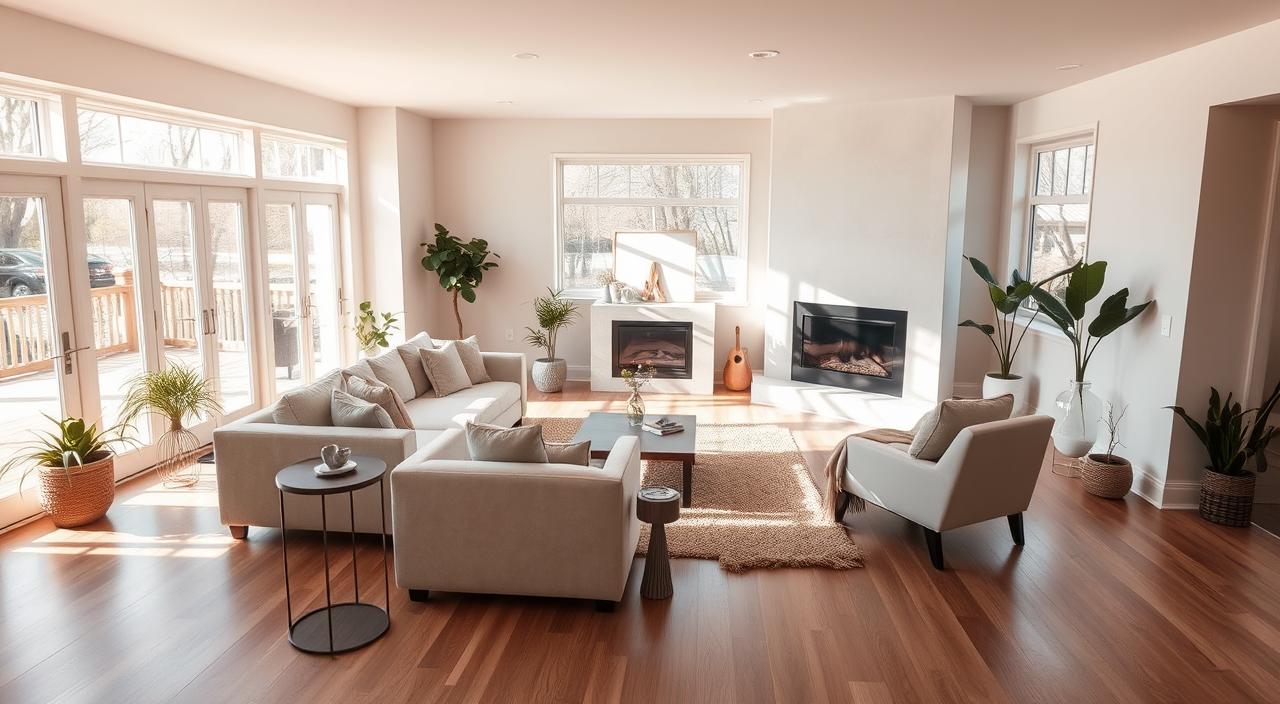
Improved Social Interaction
Open concept design encourages social interaction. It removes barriers, making it perfect for those who love to entertain or have big families.
Common Challenges in Open Floor Plans
Open concept living has its downsides too.
Noise Management
Managing noise is a big challenge. Without walls, sound can spread, causing distractions. Use sound-absorbing materials or place furniture wisely to solve this.
Maintaining Visual Order
Keeping visual order in an open space is hard. With everything merged, it’s tough to keep things looking good. Choose furniture and decor carefully to keep your space balanced and attractive.
Planning Your Open Concept Living Room Layout
Designing an open concept living room needs careful planning and smart layout choices. A well-thought-out layout can make your space feel bigger, more useful, and look great.
Assessing Your Available Space
Before furnishing your open concept living room, measure the space accurately. Take precise measurements of the room, including doors, windows, and architectural features.
Measuring and Mapping Your Area
To make a good floor plan, measure your room carefully. Use a tape measure to get the space’s dimensions. Then, map it out on graph paper or with a digital tool. Think about the ‘traffic paths’ people will follow.
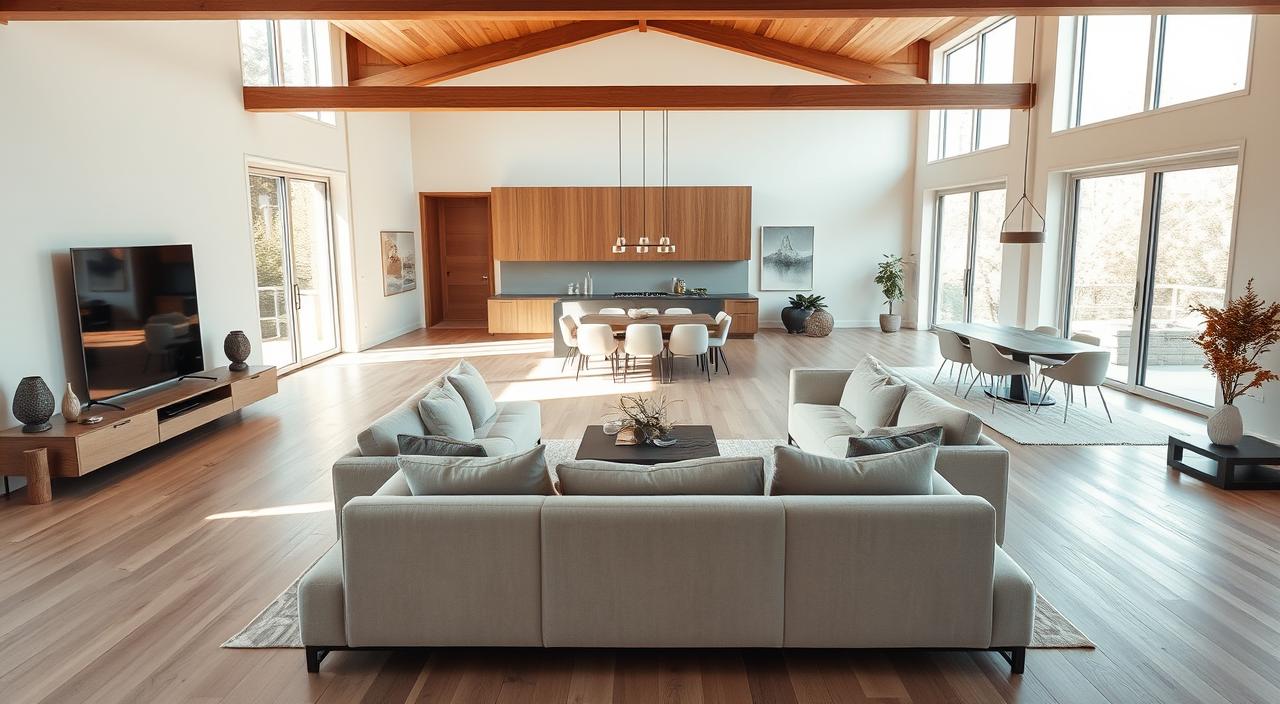
Creating a Functional Floor Plan
A functional floor plan is key for an open concept living room. You need to balance activities like lounging, dining, and cooking in the same space.
Balancing Different Activities
To get a balanced layout, think about the different zones in your open concept living room. You might have a seating area, a dining area, and a kitchen. Use furniture and rugs to define these zones while keeping the space flowing.
- Identify the main activities that will happen in the room.
- Assign a specific area for each activity.
- Use furniture and rugs to define these areas.
Traffic Flow Considerations
Traffic flow is vital in any room layout, but it’s even more important in open concept spaces. You want people to move through easily without feeling cramped or blocked.
Establishing Clear Pathways
To create clear pathways, think about the natural flow of traffic in the room. Make sure there’s enough space between furniture for people to walk comfortably. Also, avoid blocking doorways or narrow corridors.
Key considerations for traffic flow include:
- Maintaining a clear path through the room.
- Avoiding clutter and obstructions.
- Ensuring there’s enough space between furniture pieces.
Choosing a Cohesive Design Style
Creating a cohesive design style is key for open concept living rooms. It helps avoid a disjointed feel. With a large, open space, picking a design style that ties everything together is essential.
Popular Design Styles for Open Spaces
Open concept living rooms can have many design styles. But some styles work better than others. Let’s look at a couple of popular ones.
Contemporary and Minimalist Approaches
Contemporary and minimalist designs are great for open concept living rooms. These styles focus on clean lines and minimal decoration. They value function over form.
To get a contemporary look, useneutral colour palettes,sleek furniture, andample natural light.
Traditional and Transitional Options
For a classic look, traditional or transitional styles might be best. Traditional designs userich colours,ornate furnishings, anddecorative patterns. Transitional styles mix traditional elements with modern touches for a balanced space.
Maintaining Consistency Throughout the Space
To keep your open concept living room consistent, choose core elements and stick to them. This could be a dominantcolour scheme, a specificfurniture style, or a particulartexture or material. Repeating these elements creates cohesion and flow.
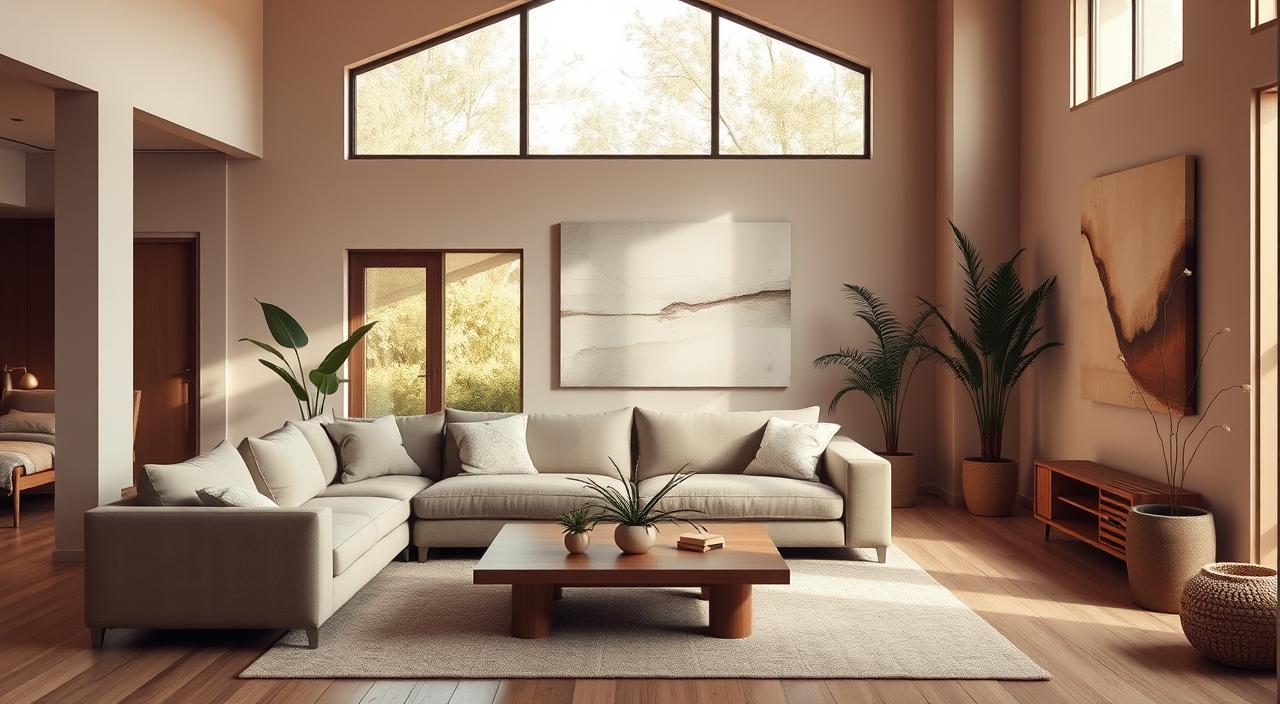
Blending Different Style Elements
While consistency is important, blending different style elements can also work. The key is to find common ground between styles. For example, pair a traditionalsofawith a contemporarycoffee tableand a transitionalrug.
By mixing and matching elements thoughtfully, you can create a space that feels curated and intentional. This way, your open concept living room will be harmonious, inviting, and uniquely yours.
Defining Zones in Your Living Room
Creating distinct zones in your open concept living room can greatly enhance its functionality and aesthetic appeal. By defining different areas within the space, you can create a more organised and visually appealing environment that meets your various needs.
Creating Visual Boundaries
Visual boundaries are essential in an open concept living room to differentiate between various zones. One effective way to achieve this is by using furniture as dividers.
Using Furniture as Dividers
Strategically placing furniture can help separate different areas within your living room. For example, a sofa can be used to create a boundary between the seating area and the rest of the room. Consider using a console table or a bench to further delineate the space.
Partial Walls and Screens
In addition to furniture, partial walls or screens can be used to create more defined boundaries. These elements can help block the line of sight between zones, creating a sense of separation without isolating areas completely. Room dividers, in particular, offer flexibility and can be moved as needed.
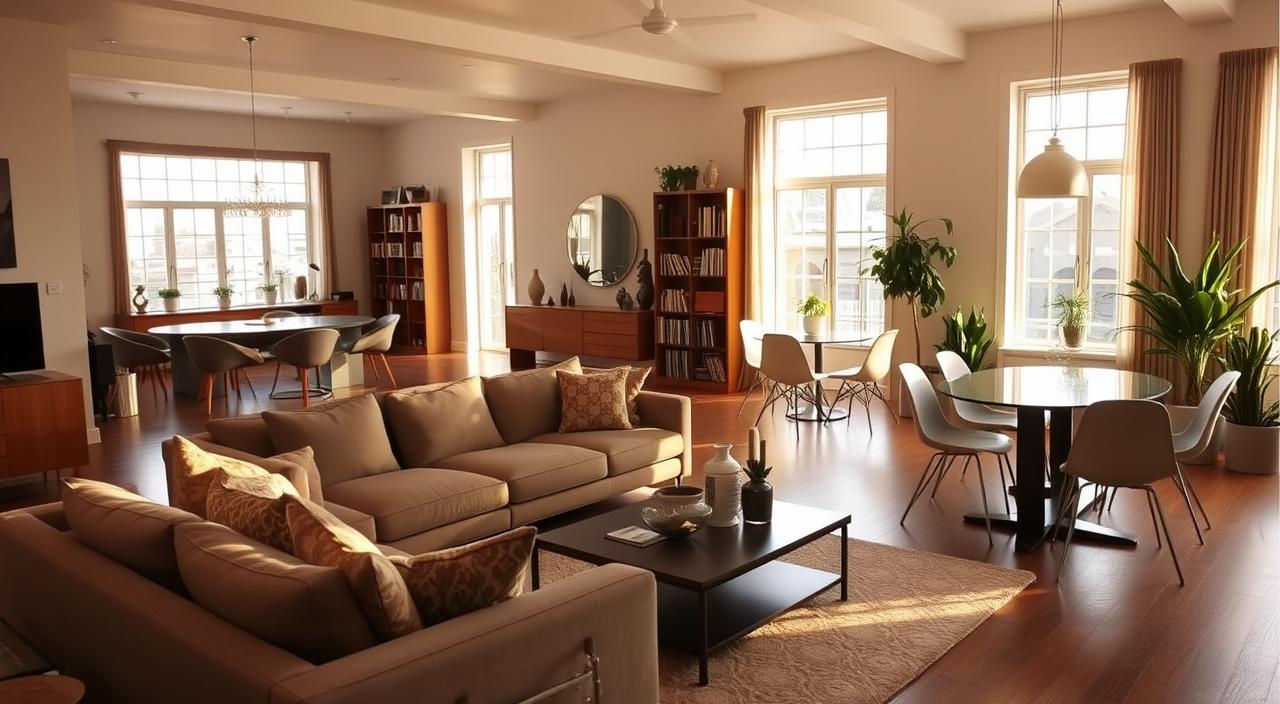
Using Rugs to Define Areas
Rugs are another effective tool for defining different zones within your open concept living room. By placing rugs of varying sizes and textures in different areas, you can visually distinguish between spaces, such as a seating area and a dining area.
Furniture Arrangement Techniques
The arrangement of furniture plays a critical role in defining zones and creating a functional living space. Thoughtful placement can facilitate conversation and interaction.
Creating Conversation Areas
To encourage social interaction, arrange furniture in a way that promotes conversation. For instance, placing sofas and armchairs in a circular configuration can create a welcoming atmosphere. Ensure that the seating is comfortable and that there is enough space for people to move around.
By implementing these strategies, you can effectively define zones in your open concept living room, making it both functional and aesthetically pleasing.
Selecting the Right Furniture for Open Concept Living
Finding the right furniture for an open concept living room is key. It should be both useful and look good. It’s important to find a balance between how it looks and how it works.
Scale and Proportion Considerations
Choosing furniture that fits the space is vital. Avoid oversized furniture to prevent the room from feeling small and messy.
Avoiding Oversized Pieces
Measure your space before buying furniture. Think about the scale of the room and how the furniture fits. Big pieces can take over, while small ones might get lost.
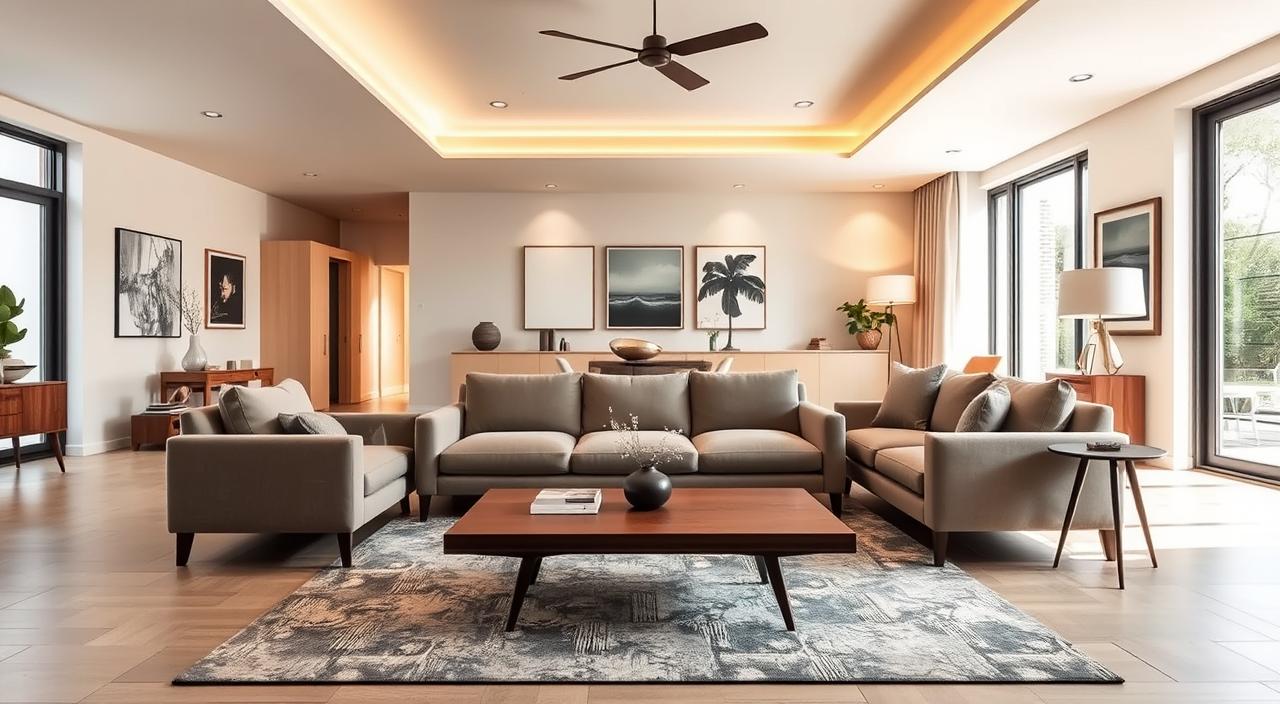
Multi-functional Furniture Options
In open concept living rooms, multi-functional furniture is a big plus. These items do more than one thing, keeping the area tidy.
Storage Ottomans and Convertible Pieces
Think about adding storage ottomans or convertible furniture. They offer extra storage and flexibility in how you use the space.
Furniture Placement Strategies
Where you put furniture is key in an open concept living room. Using floating furniture arrangements helps create zones and a flow through the space.
Floating Furniture Arrangements
Placing furniture away from walls makes a cozy area. It keeps the space open and defines different areas without walls.
Colour Schemes and Material Selection for a Cohesive Living Room
The secret to a stunning open concept living room is in choosing the right colour scheme and materials. A well-thought-out palette can tie the space together, making it feel harmonious and connected.
Creating a Unified Colour Palette
A unified colour palette is essential for a cohesive living room. Begin by picking a dominant colour for the space. Then, add accent colours to add depth and interest.
Base Colours and Accent Tones
Start with a neutral base colour that matches your home’s style. Choose bold, vibrant accent tones to add personality. Mixing warm and cool tones helps achieve balance.
- Choose a base colour that reflects the natural light in your living room.
- Select accent tones that complement your furniture and decor.
- Use a consistent ratio of base to accent colours throughout the space.
Incorporating Complementary Textures
Textures bring depth and interest to your living room. Mixing different textures creates a welcoming atmosphere.
Mixing Soft and Hard Surfaces
Pairing soft surfaces like velvet sofas with hard surfaces like wooden coffee tables balances the space. Mixing materials and textures adds complexity to your design.
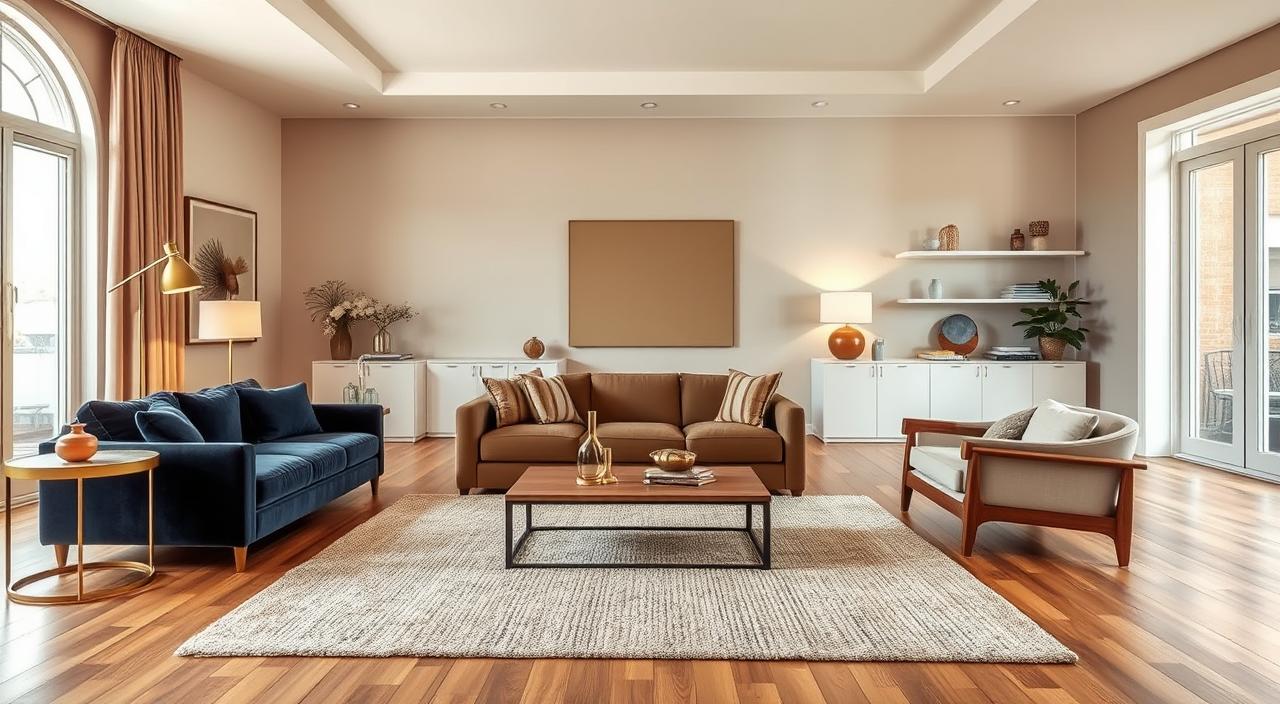
Using Accent Colours Effectively
Accent colours can highlight specific areas or connect different zones.
Creating Visual Flow Between Zones
Consistent use of accent colours creates a flow that ties zones together. This maintains harmony and cohesion in the room.
- Identify the areas you want to highlight with accent colours.
- Choose accent colours that complement your base colour and other design elements.
- Use accent colours sparingly to avoid overwhelming the space.
By selecting your colour scheme and materials wisely, you can craft a living room that is both inviting and harmonious.
Lighting Solutions for Open Concept Spaces
A good lighting plan is key for open concept living spaces. It makes the area feel connected and spacious. The right lighting can greatly improve how your living room looks and works.
Layering Different Types of Lighting
Layering lighting is vital in open concept spaces. You need to mix ambient, task, and accent lighting. This creates a space that looks good and works well.
Ambient, Task, and Accent Lighting
- Ambient Lighting: Gives the space a general glow, making it feel brighter and more welcoming.
- Task Lighting: Focuses on areas for tasks, like reading or cooking.
- Accent Lighting: Highlights special features or areas, adding depth and interest.

Zone-Specific Lighting Strategies
Zone-specific lighting helps divide the space into different areas. Using different lighting strategies, you can set up zones for different activities.
Defining Areas with Light
Lighting can help define areas. For example, use pendant lights over a dining area and table lamps in a reading nook.
Statement Lighting Fixtures
Statement lighting fixtures can add elegance and personality to your living room. Options include pendant lights and chandeliers, which can be focal points.
Pendant Lights and Chandeliers
- Pendant Lights: Great for task lighting and adding style above kitchen islands or dining tables.
- Chandeliers: Serve as a statement piece, bringing sophistication and elegance to the living area.
By using these lighting solutions, you can make your open concept living space harmonious and inviting.
Storage and Organisation in Open Living Rooms
Keeping your open living room tidy is key. You want it to look good and be functional. Finding the right balance is important for a nice space.
Integrated Storage Solutions
Integrated storage fits right in with your room’s look. It offers plenty of space without making your room feel closed in.
Decorative Storage Options
Decorative storage adds beauty to your living room. Items like baskets and boxes make your space look good while keeping things tidy.
Maintaining Visual Order
Keeping your living room looking neat is vital. Use good storage and declutter often to keep it looking great.
Decluttering Strategies
Decluttering regularly is essential. Get rid of things you don’t need or use. This keeps your space looking good and organised.
Conclusion
You now know how to make an open concept living room look great. Planning your layout, picking the right furniture, and using good lighting are key. This way, you can have a stylish and useful space.
It’s important to set up zones in your open concept living room. This helps create clear areas and keeps things organised. Use area rugs, arrange furniture, and add special lighting to each zone.
By doing these things, you can make your room look cohesive. Keep your colours, textures, and furniture style the same. This will make your open concept living room feel harmonious.

